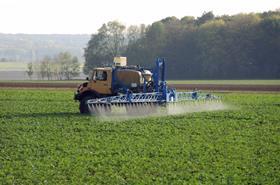
New weed control technology, which targets individual leaves of unwanted plants, could reduce herbicide inputs by 95 per cent, the AHDB has claimed.
As part of a research project being part-funded by AHDB Horticulture, experts at the University of Reading, Precision Farming Robotics, Concurrent Solutions and Knight Farm Machinery are developing an ‘automated spot herbicide ejector’.
This device will ‘point and shoot’ droplets of herbicide at individual leaves of unwanted plants in row crops, using an imaging system to distinguish these weeds from field vegetables.
Instead of using pre-emergence pesticides such as pendimethalin to prevent weeds growing in the first instance, the new technology will identify and target the individual leaves of weeds once they have emerged, killing them with a chemical called glyphosate.
By applying droplets of a systemic, non-selective herbicide to individual leaves, the project represents a paradigm shift in weed technology, according to the AHDB. Selective weed control will be achieved through engineering rather than chemistry, as is normally the case.
The University of Reading’s Alistair Murdoch, who is leading the research project, said: “This is a pioneering project, as we are exploring a combined engineering and chemical solution to weed control in field vegetables. By accurately targeting leaf-specific droplet applications, it is the ultimate in precision agriculture.”
It is “particularly important that systemic, broad-spectrum active ingredients such as glyphosate remain available to farmers and growers,” he added.
The project has been developed in response to concerns about the efficiency and dosage of herbicide use. By evaluating the dose of droplets required to kill weeds at different growth stages, the project aims to limit unnecessary herbicide use.
Precise herbicide application will also limit drift and spatter, while minimising the likelihood of run-off to soil and non-target organisms, including the crop.
Once commercialised, the system could reduce, by up to 95 per cent, herbicide inputs per unit land area. Growers are expected to benefit through lower labour and energy requirements, as well as the economic advantage of using lower volumes of herbicide.
In addition, the approach aims to address environmental issues by cutting energy inputs and soil moisture loss.
An “automated vision-guided droplet application system” should be ready for preliminary field trials in 2018.



